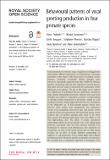Files in this item
Behavioural patterns of vocal greeting production in four primate species
Item metadata
| dc.contributor.author | Fedurek, Pawel | |
| dc.contributor.author | Neumann, Christof | |
| dc.contributor.author | Bouquet, Yaelle | |
| dc.contributor.author | Mercier, Stephanie | |
| dc.contributor.author | Magris, Martina | |
| dc.contributor.author | Quintero, Fredy | |
| dc.contributor.author | Zuberbuhler, Klaus | |
| dc.date.accessioned | 2019-04-24T11:30:01Z | |
| dc.date.available | 2019-04-24T11:30:01Z | |
| dc.date.issued | 2019-04-24 | |
| dc.identifier | 258269342 | |
| dc.identifier | 0ec4106c-2cb0-43a1-99b9-f258fa203b59 | |
| dc.identifier | 85065571936 | |
| dc.identifier | 000466513900029 | |
| dc.identifier.citation | Fedurek , P , Neumann , C , Bouquet , Y , Mercier , S , Magris , M , Quintero , F & Zuberbuhler , K 2019 , ' Behavioural patterns of vocal greeting production in four primate species ' , Royal Society Open Science , vol. 6 , no. 4 , 182181 . https://doi.org/10.1098/rsos.182181 | en |
| dc.identifier.issn | 2054-5703 | |
| dc.identifier.other | ORCID: /0000-0001-8378-088X/work/64360655 | |
| dc.identifier.uri | https://hdl.handle.net/10023/17587 | |
| dc.description | The study was funded by Swiss National Science Foundation (310030_143359) and European Research Council (PRILANG 283871) project grants awarded to K.Z. | en |
| dc.description.abstract | Social animals have evolved a range of signals to avoid aggressive and facilitate affiliative interactions. Vocal behaviour is especially important in this respect with many species, including various primates, producing acoustically distinct ‘greeting calls’ when two individuals approach each other. While the ultimate function of greeting calls has been explored in several species, little effort has been made to understand the mechanisms of this behaviour across species. The aim of this study was to explore how differences in individual features (individual dominance rank), dyadic relationships (dominance distance and social bond strength) and audience composition (presence of high-ranking or strongly bonded individuals in proximity), related to vocal greeting production during approaches between two individuals in the philopatric sex of four primate species: female olive baboons (Papio anubis), male chimpanzees (Pan troglodytes), female sooty mangabeys (Cercocebus atys) and female vervet monkeys (Chlorocebus pygerythrus). We found that female vervet monkeys did not produce greeting calls, while in the other three species, low-ranking individuals were more likely to call than high-ranking ones. The effects of dyadic dominance relationships differed in species-specific ways, with calling being positively associated with the rank distance between two individuals in baboons and chimpanzees, but negatively in mangabeys. In none of the tested species did we find strong evidence for an effect of dyadic affiliative relationships or audience on call production. These results likely reflect deeper evolutionary layers of species-specific peculiarities in social style. We conclude that a comparative approach to investigate vocal behaviour has the potential to not only better understand the mechanisms mediating social signal production but also to shed light on their evolutionary trajectories. | |
| dc.format.extent | 13 | |
| dc.format.extent | 1016377 | |
| dc.language.iso | eng | |
| dc.relation.ispartof | Royal Society Open Science | en |
| dc.subject | Greeting calls | en |
| dc.subject | Audience effects | en |
| dc.subject | Vocal production | en |
| dc.subject | Dyadic encounters | en |
| dc.subject | Communication | en |
| dc.subject | BF Psychology | en |
| dc.subject | QL Zoology | en |
| dc.subject | DAS | en |
| dc.subject.lcc | BF | en |
| dc.subject.lcc | QL | en |
| dc.title | Behavioural patterns of vocal greeting production in four primate species | en |
| dc.type | Journal article | en |
| dc.contributor.institution | University of St Andrews. Institute of Behavioural and Neural Sciences | en |
| dc.contributor.institution | University of St Andrews. Centre for Social Learning & Cognitive Evolution | en |
| dc.contributor.institution | University of St Andrews. School of Psychology and Neuroscience | en |
| dc.identifier.doi | 10.1098/rsos.182181 | |
| dc.description.status | Peer reviewed | en |
This item appears in the following Collection(s)
Items in the St Andrews Research Repository are protected by copyright, with all rights reserved, unless otherwise indicated.

